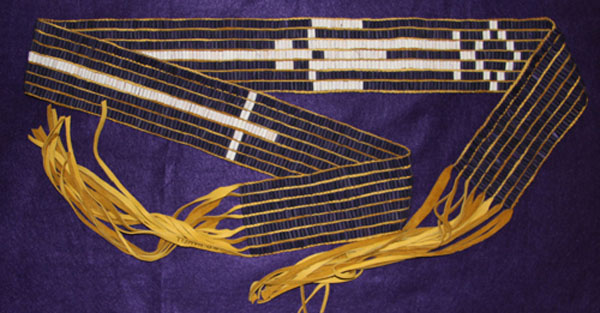 |
 |
Photographs (left to right): Capitol Reef National Park, Utah; Mohave Desert, Nevada; Capitol Reef National Park, Utah
Wampum Belt Archive
Remembrance Belt

Original (Courtesy New York State Museum)

Miniaturized version in glass beads (See Stolle, Nickolaus description below)
SMF-Stadtische Museen Friedburg, Friedburg, im Breisgau, Germany

Reproduction R. D. Hamell (Polymer Beads)
February 25 2013
Original Size: |
Length, 40.4 inches. Width: 2.5 inches. Rows: 341 rows by 7 beads wide. Total 2,387 beads. |
Reproduction: |
Length: 57.5 inches. Width: 3.2 inches. Total length with fringe: 81.5 inches. |
Beads: |
Rows: 341 rows by 7 beads wide. Total 2,387 beads. |
Materials: |
Warp: Leather. Weave: Artificial Sinew. |
Description:
A long narrow purple pictographic belt. The beads are strung on fine white thread and woven over buckskin thongs. It is in perfect condition.
The traditional description does not seem to be appropriate in that it mentions it carries the figure of a "Long House" (the symbol of the Confederacy) at one end, which is. connected to a cross at the other by a long single ribbon of white beads. Donaldson's interpretation (Beauchamp, '01, p. 414) is more apt: "the guarded approach of strangers to the councils of the Five Nations" is shown by the figure of a man before an open diamond-shaped figure which could be the -representation of an Indian Castle.
The cross was sometimes used to symbolize Canada, but instead of its referring to French Canada, Doctor Beauchamp thought "it is more likely to have been Moravian," as the Moravian Indians produced a somewhat similar belt in 1775 at the Grand Council of the Delawares and there was more or less intercourse between the Moravians and the Onondagas.
Arthur
C. Parker believes the belt "records the treachery of a French missionary
at Onondaga who sought to summon the French army from
Thomas
Webster's interpretation and record (Beauchamp, '01, p. 422) (inaccurate,
but interesting) given at Onondaga in 1886 follows: "The priest told
the Onondagas that a building right by the mission house--and told them
that there were goods there stored for the Onondagas, but he could not
open them until the king came, and a white boy who had been captured had
been told by the priest that it was full of arms-and when the king came
they would annihilate the Onondagas. The boy told the chief, and they
held a council and resolved to open the building. The priest tried to
keep them from it, but they opened the door in spite of him, and found
the building full of arms. They heated an ax red-hot, and hung it upon
the priest's heart, and it burnt his heart out. The French did come, and
the Onondagas met them at Camden, and defeated them in a great battle, and then
the Onondagas all renounced Catholicism. It was between Pompey and
Jamesville, about this side of Pompey Hill. Cross means
Kocac (2016): Purchased by the institution in 1898, acquired by Paige Richmond from the Onondaga Nations the same year earlier.
Glass beaded belt, miniaturized; 7 rows, 75.5cm. SMF III-68-1951. Acquired from Arthur Speyer, Sr. exchanged by him in 1956 from the LMS 050469 (Linden-Museum Stuttgart, Stuttgart, Germany), purchased by Robert Franck in 1907, collected by Emil W. Lenders, made of the same beads as used by Frank G. Speck for recreated Penobscot Belts.
Reference:
Clarke, Noah T. 1931 New York State Museum Bulletin No. 288, Fig. 28.
 |
 |
 |
 |
 |
 |
 |
 |
|---|